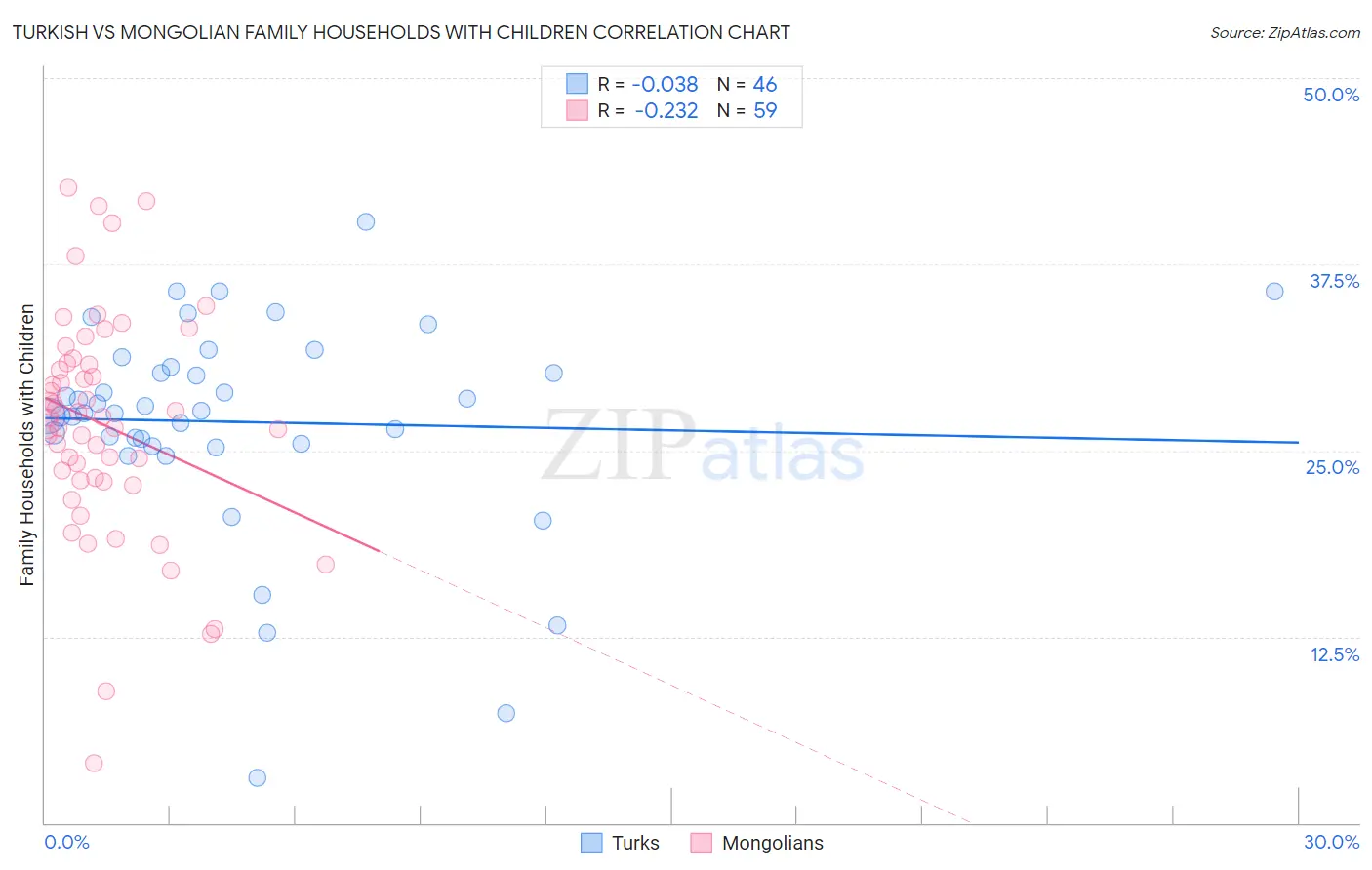Turkish vs Mongolian Family Households with Children
COMPARE
Turkish
Mongolian
Family Households with Children
Family Households with Children Comparison
Turks
Mongolians
27.4%
FAMILY HOUSEHOLDS WITH CHILDREN
46.9/ 100
METRIC RATING
179th/ 347
METRIC RANK
27.6%
FAMILY HOUSEHOLDS WITH CHILDREN
70.7/ 100
METRIC RATING
159th/ 347
METRIC RANK
Turkish vs Mongolian Family Households with Children Correlation Chart
The statistical analysis conducted on geographies consisting of 271,630,729 people shows no correlation between the proportion of Turks and percentage of family households with children in the United States with a correlation coefficient (R) of -0.038 and weighted average of 27.4%. Similarly, the statistical analysis conducted on geographies consisting of 140,279,389 people shows a weak negative correlation between the proportion of Mongolians and percentage of family households with children in the United States with a correlation coefficient (R) of -0.232 and weighted average of 27.6%, a difference of 0.55%.

Family Households with Children Correlation Summary
| Measurement | Turkish | Mongolian |
| Minimum | 3.0% | 4.0% |
| Maximum | 40.4% | 42.6% |
| Range | 37.3% | 38.6% |
| Mean | 26.9% | 26.7% |
| Median | 27.6% | 27.2% |
| Interquartile 25% (IQ1) | 25.4% | 23.0% |
| Interquartile 75% (IQ3) | 30.6% | 30.8% |
| Interquartile Range (IQR) | 5.2% | 7.8% |
| Standard Deviation (Sample) | 7.2% | 7.5% |
| Standard Deviation (Population) | 7.1% | 7.5% |
Demographics Similar to Turks and Mongolians by Family Households with Children
In terms of family households with children, the demographic groups most similar to Turks are Spanish American (27.4%, a difference of 0.040%), Ugandan (27.4%, a difference of 0.050%), Immigrants from China (27.4%, a difference of 0.060%), White/Caucasian (27.4%, a difference of 0.070%), and British (27.4%, a difference of 0.070%). Similarly, the demographic groups most similar to Mongolians are Subsaharan African (27.6%, a difference of 0.080%), Alaskan Athabascan (27.6%, a difference of 0.090%), Immigrants from Bangladesh (27.6%, a difference of 0.10%), Czech (27.5%, a difference of 0.14%), and Immigrants from Hong Kong (27.5%, a difference of 0.15%).
| Demographics | Rating | Rank | Family Households with Children |
| Mongolians | 70.7 /100 | #159 | Good 27.6% |
| Sub-Saharan Africans | 67.5 /100 | #160 | Good 27.6% |
| Alaskan Athabascans | 67.1 /100 | #161 | Good 27.6% |
| Immigrants | Bangladesh | 67.0 /100 | #162 | Good 27.6% |
| Czechs | 65.3 /100 | #163 | Good 27.5% |
| Immigrants | Hong Kong | 64.9 /100 | #164 | Good 27.5% |
| Immigrants | South Africa | 61.3 /100 | #165 | Good 27.5% |
| Immigrants | Nonimmigrants | 61.2 /100 | #166 | Good 27.5% |
| Dominicans | 61.1 /100 | #167 | Good 27.5% |
| Immigrants | Kuwait | 60.9 /100 | #168 | Good 27.5% |
| Seminole | 56.9 /100 | #169 | Average 27.5% |
| Cherokee | 56.7 /100 | #170 | Average 27.5% |
| Blackfeet | 54.3 /100 | #171 | Average 27.5% |
| Israelis | 53.9 /100 | #172 | Average 27.5% |
| Immigrants | Argentina | 52.2 /100 | #173 | Average 27.5% |
| Whites/Caucasians | 50.0 /100 | #174 | Average 27.4% |
| British | 49.9 /100 | #175 | Average 27.4% |
| Immigrants | China | 49.6 /100 | #176 | Average 27.4% |
| Ugandans | 49.2 /100 | #177 | Average 27.4% |
| Spanish Americans | 48.9 /100 | #178 | Average 27.4% |
| Turks | 46.9 /100 | #179 | Average 27.4% |